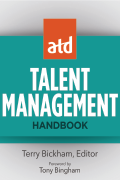The Public Manager Magazine Article
A Handbook to Attracting, Keeping, and Developing Top Talent
The ATD Talent Management Handbook is a compendium of all things talent management—from needs assessment to onboarding to performance improvement to change management.
Tue May 10 2016

"Organizations that understand the purpose and practices of effective talent development—and its role within talent management—will be well positioned for the world of work in the 21st century," Association for Talent Development president and CEO Tony Bingham writes in the foreword of the ATD Talent Management Handbook.
How does an employer strategically build a brand to attract and keep top talent? How do you engage employees and leverage talent analytics to optimize both individual and organizational performance? And finally, how do you incorporate leadership development and succession planning into all levels of the organization?
Addressing these issues, the handbook is a compendium of all things talent development—from needs assessment to onboarding to performance improvement to change management. Edited by Terry Bickham, a retired U.S. Coast Guard officer who also served as chief learning officer at the Library of Congress and as assistant administrator for workforce performance and training at the Transportation Security Administration, the ATD Talent Management Handbook, published in November 2015, looks at talent development as a fluid process rather than a series of transactions.
In chapter 1, "Easy-to-Use Approaches to Attract Top Talent," John Sullivan encourages employers to spread their brand image and highlight job features. "Employer branding is an image-building process that makes it easy for all prospects to find out about what makes your organization a desirable place to work," he writes.
An exemplary example of how that is done in the public sector is Saskia van Gendt's video from USAJobs.gov. In it, van Gendt talks about her work at the Environmental Protection Agency and the impact of greenhouse gas emissions, materials conservation, and the Lifecycle Building Challenge on climate change. Besides discussing the value of EPA's work, van Gendt also talks about the amount of learning she has experienced, the training opportunities she has been provided, and being inspired by her co-workers.
Sullivan encourages organizations to identify where top performers who aren't looking for jobs would find out about your agency. Make sure your company's information and branding are there, and determine what would attract top prospects (flexibility, learning, and so on).
Some errors that organizations make with respect to attracting top talent, according to Sullivan, include:
not recognizing the advantages your organization has to offer
underleveraging employee referrals
using dull position descriptions.
The ATD Talent Management Handbook also has guidance for onboarding as well as the not-often-talked-about inboarding, or onboarding for internally transferring employees.
Sarah Hagerman, Lilith Christiansen, and Mark Stein observe that "a systemic approach \[to onboarding\] will identify all the business processes that affect the new hire so they can be coordinated to produce one tailored experience." Leadership and management buy-in to the importance of onboarding is critical, say the authors. Because it's so important—a strategic initiative, write the trio—the onboarding program should be branded for both new hires and existing employees.
In the chapter "Designing Inboarding (Onboarding for Internal Transfers)," Hagerman, Christiansen, and Stein urge organizations not to assume that employees who are familiar with an organization will be able to step easily into a new role: "Just because \[employees\] have been at their organization for several years does not mean that they will understand how to operate effectively in a new role, department, or even country from day one. The experience can be challenging and exciting—or completely overwhelming—all depending on whether their organization has invested in a systemic approach to effectively inboard them to their new role and team."
